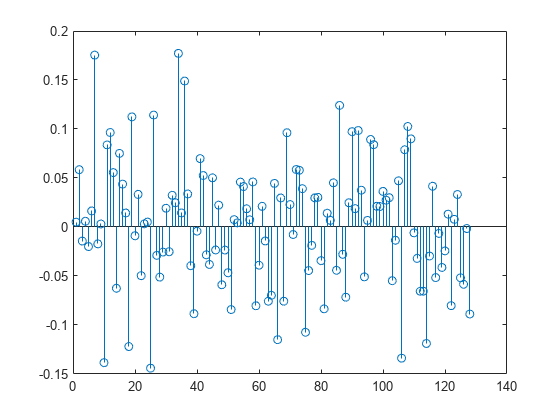순환 전치를 사용하지 않는 기본 OFDM
OFDM은 중첩된 정현파의 좁은 간격으로 배치된 직교 부반송파 신호들을 동시에 송신합니다. 송신 데이터는 먼저 코딩되고 변조되며 일반적으로 QAM 심볼을 사용합니다. 이들 심볼을 동일한 간격의 주파수 Bin으로 불러온 후 고속 푸리에 역변환(IFFT)을 적용하여 신호를 시간 영역에서 직교 중첩 정현파(부반송파)로 변환합니다. 각 부반송파가 협대역이고 평탄 페이딩(flat fading)을 거치기 때문에 수신기 측 이퀄라이제이션에는 부반송파당 하나의 탭만 필요합니다.
간단한 OFDM 시스템을 만듭니다. 단일 반송파 16QAM 신호를 OFDM 변조기 입력으로 사용합니다. 줄기 플롯에서 모든 주파수 Bin에 데이터가 포함되어 있음을 보여줍니다.
bps = 4; % Bits per symbol M = 2^bps; % 16QAM nFFT = 128; % Number of FFT bins txsymbols = randi([0 M-1],nFFT,1); txgrid = qammod(txsymbols,M,UnitAveragePower=true); txout = ifft(txgrid,nFFT); stem(1:nFFT,real(txout))

송신 데이터를 최소 잡음을 가진 AWGN 채널을 통해 필터링합니다. OFDM 수신은 송신 처리 과정을 역으로 수행합니다. FFT와 QAM 복조를 적용한 후 수신된 심볼이 송신된 심볼과 일치하는지 확인합니다.
rxin = awgn(txout,40); rxgrid = fft(rxin,nFFT); rxsymbols = qamdemod(rxgrid,M,UnitAveragePower=true); if isequal(txsymbols,rxsymbols) disp("Recovered symbols match the transmitted symbols.") else disp("Recovered symbols do not match transmitted symbols.") end
Recovered symbols match the transmitted symbols.
IFFT의 모든 Bin이 해당 송신의 데이터로 채워집니다. 실제 시스템에서는 보호 대역으로 사용하기 위해 경계 Bin을 비워 두는 경우가 많으며 일부 Bin은 특정 파일럿 신호를 보내는 데 사용될 수 있습니다. 보호 대역과 파일럿 신호를 조합하면 동기화와 이퀄라이제이션에 도움이 됩니다.